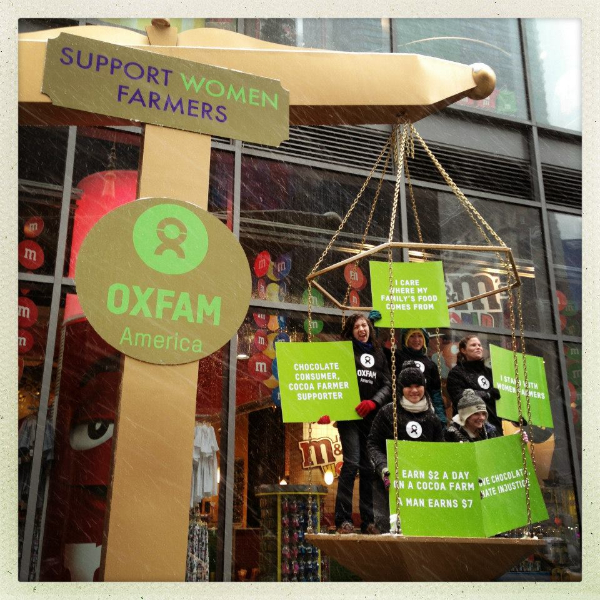‘Critical Friends’: The dos & don’ts of corporate campaigning, Oxfam-style
 Oxfam campaigners outside the M&M's store in Times Square in March of 2013. Photo: Peter DiCampo
Oxfam campaigners outside the M&M's store in Times Square in March of 2013. Photo: Peter DiCampo
A campaigner reflects on the formula and factors that have garnered important commitments from the big 10 food and beverage companies.
Over the last three years I have been a corporate campaign strategist for our Behind the Brands campaign, one of Oxfam’s most successful campaigns to date. Lately, I’ve been reflecting on the formula and factors that have garnered important commitments from the big 10 food and beverage companies as well as accolades from others; “Oxfam is one of the few NGOs that seems able to balance the use of carrot and stick with major corporates, calling out bad performance while still celebrating the good.” Trade Unions have been corporate campaigning since their existence but digital tools have taken activism from being just about people on the streets to new era of activism. But not all corporate campaigns are the same and Oxfam has garnered both criticism and praise for our corporate campaign style.
Campaigning is a set of actions targeted at an individual or institution in order to make a change. Oxfam has been very deliberate about the tools and tactics it has chosen to use in the Behind the Brands campaign and refrained from others even when they are effective. For example, in Behind the Brands we have never personalized our corporate targets, e.g., going after the CEO. This is a well-known tactic in corporate campaigning that many organizations use because it puts direct pressure on a decision-maker. While organizations like Greenpeace and Rainforest Action Network have successfully used outrageous and media grabbing stunts to attract attention and public support, Oxfam has used a combination of tactics and approaches to gain corporate commitments. We try to ensure that our campaigning walks a moderate line: hard hitting enough to convey urgency so supporters will act while at the same time not so aggressive that relations with a company become too strained. So, what is the Oxfam formula for our Behind the Brands campaigning?
Oxfam combines evidenced-based advocacy using deep company engagement, combined with digital mobilization, media, offline and online stunts, advertising, investor and shareholder activism, case studies, and collaboration with allies and influencers. Our evidence-based advocacy on Behind the Brands has always included a justification of our targeted companies along with a business case that also highlights best practice. Oxfam has taken a “critical friend” approach on Behind the Brands. Why and what does that mean?
Many corporate campaigns personalize a company through the CEO or other decision-makers; they may call for boycotts or generally paint the company as inherently bad. Oxfam, on the other hand, does not call for boycotts because the impact is generally felt but the communities for whom we are advocating (e.g., farmers and workers). Rather, Behind the Brands has taken the approach that the private sector can be a positive actor for development. In garnering several commitments on the campaign, Oxfam has also taken into account the fact that we will work with a company on implementing those commitments not only as a watchdog to ensure that they follow through but also as an advisor on how best to do it. Keeping this mind, aggressive campaigns can mean a real hangover after the celebration of a win. After all, at the end of the day relationships between Oxfam and the company sit with individuals and when there are hard feelings between those individuals it makes it challenging to work together, even on shared outcomes and interests.
So, what’s the Behind the Brands code for corporate-campaigning?
DO:
- Be respectful.
- Create a realistic ask: Campaign for something that the company can actually deliver;
- Justify your campaign with evidence.
- Follow the lead of your supporters, allies, and community you claim to represent: Openly communicate and carefully listen to your constituency.
- Give the company the chance to do the right thing: don’t campaign for campaign’s sake, give the company a chance to right the wrong before going public.
DON’T:
- Ambush the company: Provide a right of response and review for materials you will be making public. Be transparent with what we want and what we are going to do without jeopardizing your strategy.
- Target individuals: This should be a last resort tactic. Similarly treat company brands with respect. Calling for change does not need to be a smear campaign. Only make accusations where you have evidence and legitimate cause.
Being an activist is being a strategist, and various strategies can create similar outcomes; there is room and space for all kinds of activists. After all, Martin Luther King and Malcolm X did not go about the civil rights movement in the same way, but both sought to deliver equality for their people. Oxfam respects and recognizes the need for other campaign styles but so far, we’ve seen some good success with the one we’ve employed on Behind the Brands.